
Concept explainers
(a)
Interpretation:
A steroid is to be classified as saponifiable or nonsaponifiable lipid.
Concept introduction:
Lipids are one of those macromolecular substances that are present in the living cell. The cell membrane of the living cell is made up of lipids. The lipids have a greasy, waxy and oily texture. The lipids are insoluble in water. They include natural oils, waxes, and steroids.
Answer to Problem 18.4E
A steroid is a nonsaponifiable lipid.
Explanation of Solution
A hydrolysis reaction carried out in a basic solution is known as saponification reaction. The term saponifiable lipids indicate the lipids that can undergo saponification reaction. The lipids that have ester group are saponifiable lipids. The basic structure of steroid is composed of three six-member ring and one five-member ring. The steroid ring system is shown below.
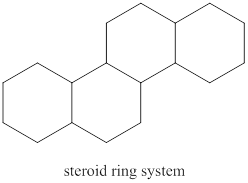
Figure 1
The basic structure of steroid does not have any ester group. Therefore, a steroid is a nonsaponifiable lipid.
A steroid is a nonsaponifiable lipid.
(b)
Interpretation:
Wax is to be classified as saponifiable or nonsaponifiable lipid.
Concept introduction:
Lipids are one of those macromolecular substances that are present in the living cell. The cell membrane of the living cell is made up of lipids. The lipids have a greasy, waxy and oily texture. The lipids are insoluble in water. They include natural oils, waxes, and steroids.
Answer to Problem 18.4E
Wax is a saponifiable lipid.
Explanation of Solution
A hydrolysis reaction carried out in a basic solution is known as saponification reaction. The term saponifiable lipids indicate the lipids that can undergo saponification reaction. The lipids that have ester group are saponifiable lipids. The wax is an ester of long-chain alcohol and a fatty acid. The structure of a simple wax that is beeswax is shown below.
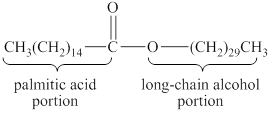
Figure 2
The basic structure of wax has an ester group. Therefore, wax is a saponifiable lipid.
Wax is a saponifiable lipid.
(c)
Interpretation:
A triglyceride is to be classified as saponifiable or nonsaponifiable lipid.
Concept introduction:
Lipids are one of those macromolecular substances that are present in the living cell. The cell membrane of the living cell is made up of lipids. The lipids have a greasy, waxy and oily texture. The lipids are insoluble in water. They include natural oils, waxes, and steroids.
Answer to Problem 18.4E
A triglyceride is a saponifiable lipid.
Explanation of Solution
A hydrolysis reaction carried out in a basic solution is known as saponification reaction. The term saponifiable lipids indicate the lipids that can undergo saponification reaction. The lipids that have ester group are saponifiable lipids. The triglyceride is formed from glycerol and three fatty acids with ester bonds. The general structure of triglyceride is shown below.
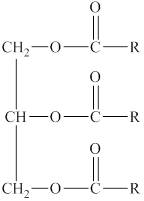
Figure 3
The basic structure of triglyceride has ester groups. Therefore, a triglyceride is a saponifiable lipid.
A triglyceride is a saponifiable lipid.
(d)
Interpretation:
A phosphoglyceride is to be classified as saponifiable or nonsaponifiable lipids.
Concept introduction:
Lipids are one of those macromolecular substances that are present in the living cell. The cell membrane of the living cell is made up of lipids. The lipids have a greasy, waxy and oily texture. The lipids are insoluble in water. They include natural oils, waxes, and steroids.
Answer to Problem 18.4E
A phosphoglyceride is a saponifiable lipid.
Explanation of Solution
A hydrolysis reaction carried out in a basic solution is known as saponification reaction. The term saponifiable lipids indicate the lipids that can undergo saponification reaction. The lipids that have ester group are saponifiable lipids. The structure of phosphoglyceride is similar to that of a triglyceride. The only difference between triglyceride and phosphoglyceride is that on the third carbon of glycerol, a phosphate group is attached in the phosphoglyceride. The general structure of phosphoglyceride is shown below.
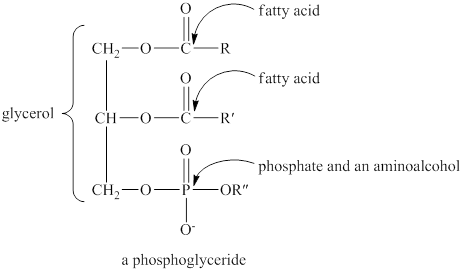
Figure 4
The basic structure of phosphoglyceride has ester groups. Therefore, a phosphoglyceride is a saponifiable lipid.
A phosphoglyceride is a nonsaponifiable lipid.
(e)
Interpretation:
A glycolipid is to be classified as saponifiable or nonsaponifiable lipid.
Concept introduction:
Lipids are one of those macromolecular substances that are present in the living cell. The cell membrane of the living cell is made up of lipids. The lipids have a greasy, waxy and oily texture. The lipids are insoluble in water. They include natural oils, waxes, and steroids.
Answer to Problem 18.4E
A glycolipid is a saponifiable lipid.
Explanation of Solution
A hydrolysis reaction carried out in a basic solution is known as saponification reaction. The term saponifiable lipids indicate the lipids that can undergo saponification reaction. The lipids that have ester group are saponifiable lipids. The glycolipid contains carbohydrate in it. The glycolipids are also termed as cerebroside as they are present in the brain. The typical structure of glycolipid (cerebroside) is shown below.
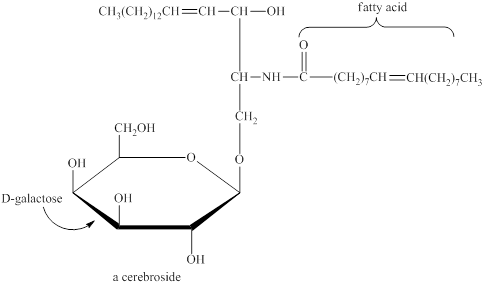
Figure 5
The basic structure of glycolipid does not have an ester group but they have an amide group that can undergo saponification. Therefore, a glycolipid is a saponifiable lipid.
A glycolipid is a saponifiable lipid.
(f)
Interpretation:
A prostaglandin is to be classified as saponifiable or nonsaponifiable lipid.
Concept introduction:
Lipids are one of those macromolecular substances that are present in the living cell. The cell membrane of the living cell is made up of lipids. The lipids have a greasy, waxy and oily texture. The lipids are insoluble in water. They include natural oils, waxes, and steroids.
Answer to Problem 18.4E
Prostaglandin is a nonsaponifiable lipid.
Explanation of Solution
A hydrolysis reaction carried out in a basic solution is known as saponification reaction. The term saponifiable lipids indicate the lipids that can undergo saponification reaction. The lipids that have ester group are saponifiable lipids. The basic structure prostaglandin is composed of a five-member ring with two substituted carbon chain. The structure of prostaglandin
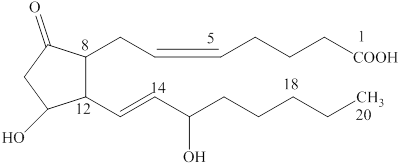
Figure 6
The basic structure of prostaglandin does not have an ester group. Therefore, a prostaglandin is a nonsaponifiable lipid.
Prostaglandin is a nonsaponifiable lipid.
Want to see more full solutions like this?
Chapter 18 Solutions
Bundle: Chemistry For Today: General, Organic, And Biochemistry, 9th + Owlv2 With Mindtap Reader, 1 Term (6 Months) Printed Access Card
- eks.com/aleksogi/x/sl.exe/1o_u-IgNslkr7j8P3jH-IQs_pBanHhvTCeeBZbufuBYTI0Hz7m7D3ZS17Hd6m-HIl6n52njJN-TXdQA2X9yID-1SWQJTgnjARg30 111 States of Matter Understanding conceptual components of the enthalpy of solution 0/5 Ge A small amount of acetonitrile (CH, CN) is dissolved in a large amount of water. Imagine separating this process into the four stages sketched below. (These sketches show only a portion of the substances, so you can see the density and distribution of atoms and molecules in them.) CH,CN H₂O B 88 C Use these sketches to answer the questions in the table below. The enthalpy of solution AH is negative soln when CH3CN dissolves in water. Use this information to list the stages in order of increasing enthalpy. Would heat be absorbed or released if the system moved from Stage C to D? What force would oppose or favor the system moving from Stage C to D? Check all that apply. 1 absorbed O released neither absorbed nor released. none O ionic bonding force covalent bonding force…arrow_forwardIn a system with an anodic overpotential, the variation of ŋ as a function of the current density: 1. at low fields is linear 2. at higher fields, it follows Tafel's law Find the range of current densities for which the overpotential has the same value as when calculated for cases 1 and 2 (maximum relative difference of 5% with respect to the behavior for higher fields). To which overpotential range does this correspond? Data: 10 = 1.5 mA cm², T = 300°C, ẞ = 0.64, R = 8.314 J K 1 mol¹ and F = 96485 C mol-1.arrow_forwardIndicate 10.6 with only one significant figure.arrow_forward
- If I have 10 data points for variables x and y, when I represent y versus x I obtain a line with the equation y = mx + b. Is the slope m equal to dy/dx?arrow_forwardThe data for the potential difference of a battery and its temperature are given in the table. Calculate the entropy change in J mol-1 K-1 (indicate the formulas used).Data: F = 96485 C mol-1arrow_forwardIn a cell, the change in entropy (AS) can be calculated from the slope of the E° vs 1/T graph. The slope is equal to -AS/R, where R is the gas constant. Is this correct?arrow_forward
- Using the Arrhenius equation, it is possible to establish the relationship between the rate constant (k) of a chemical reaction and the temperature (T), in Kelvin (K), the universal gas constant (R), the pre-exponential factor (A) and the activation energy (Ea). This equation is widely applied in studies of chemical kinetics, and is also widely used to determine the activation energy of reactions. In this context, the following graph shows the variation of the rate constant with the inverse of the absolute temperature, for a given chemical reaction that obeys the Arrhenius equation. Based on the analysis of this graph and the concepts acquired about the kinetics of chemical reactions, analyze the following statements: I. The activation energy (Ea) varies with the temperature of the system. II. The activation energy (Ea) varies with the concentration of the reactants. III. The rate constant (K) varies proportionally with temperature. IV. The value of the…arrow_forwardIn an electrolytic cell, indicate the formula that relates E0 to the temperature T.arrow_forward-- 14:33 A Candidate Identification docs.google.com 11. Compound A can transform into compound B through an organic reaction. From the structures below, mark the correct one: HO A تھے۔ די HO B ○ A) Compounds A and B are isomers. B) Both have the same number of chiral carbons. C) Compound A underwent an addition reaction of Cl2 and H2O to form compound B. D) Compound A underwent a substitution reaction forming the intermediate chlorohydrin to obtain compound B. E) Compound A underwent an addition reaction of Cl2 forming the chloronium ion and then added methanol to obtain compound B. 60arrow_forward
 Chemistry for Today: General, Organic, and Bioche...ChemistryISBN:9781305960060Author:Spencer L. Seager, Michael R. Slabaugh, Maren S. HansenPublisher:Cengage LearningChemistry: Matter and ChangeChemistryISBN:9780078746376Author:Dinah Zike, Laurel Dingrando, Nicholas Hainen, Cheryl WistromPublisher:Glencoe/McGraw-Hill School Pub Co
Chemistry for Today: General, Organic, and Bioche...ChemistryISBN:9781305960060Author:Spencer L. Seager, Michael R. Slabaugh, Maren S. HansenPublisher:Cengage LearningChemistry: Matter and ChangeChemistryISBN:9780078746376Author:Dinah Zike, Laurel Dingrando, Nicholas Hainen, Cheryl WistromPublisher:Glencoe/McGraw-Hill School Pub Co
 World of ChemistryChemistryISBN:9780618562763Author:Steven S. ZumdahlPublisher:Houghton Mifflin College Div
World of ChemistryChemistryISBN:9780618562763Author:Steven S. ZumdahlPublisher:Houghton Mifflin College Div Introductory Chemistry: A FoundationChemistryISBN:9781337399425Author:Steven S. Zumdahl, Donald J. DeCostePublisher:Cengage Learning
Introductory Chemistry: A FoundationChemistryISBN:9781337399425Author:Steven S. Zumdahl, Donald J. DeCostePublisher:Cengage Learning Organic ChemistryChemistryISBN:9781305580350Author:William H. Brown, Brent L. Iverson, Eric Anslyn, Christopher S. FootePublisher:Cengage Learning
Organic ChemistryChemistryISBN:9781305580350Author:William H. Brown, Brent L. Iverson, Eric Anslyn, Christopher S. FootePublisher:Cengage Learning





